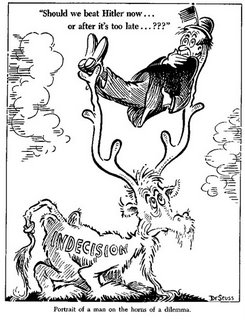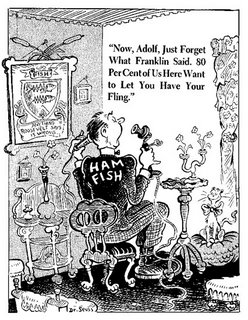
This is a guy who I was surprised to learn had a very active political cartoon career before he made the jump to children’s books. I’ve tried to include some of the favourites I’ve found around the web but there is plethora of good stuff out there. It’s all very biting and critical about the non-committal stance America was taking towards the war in Europe. It was something that was very obviously a war of good versus evil which makes the cartoons scary. I find them scary for their ability to invoke a time when America wasn’t so willing to jump into armed conflict. It just doesn’t jive with how things are playing out in the world today. It reminds of how much American businesses were turning a profit by playing both sides of the conflict. For instance, Coca-cola created Fanta to sell in Germany but they were one company. It shows how interest other than doing the right thing was very hard to overcome until Pearl Harbour. This tough stance and dealing with tough issues outright would always come back to Seuss and his work.

After 27 rejections, Dr. Seuss basically took up a challenge that was presented in an article on children’s school primers. The article, which Dr. Seuss agreed with, complained that these books aimed at children were to antiseptic presenting a world that is way too sparkling clean for children to identify with. The result was an agreement between to publishing houses to print Dr. Seuss’s school primer The Cat in the Hat. One publisher sold the book as a textbook to schools and the other sold it to parents. Next to none were sold to schools but parents grabbed copies off the shelves hand over fist.
Then the rest of the works went from there. Dr. Seuss was able to purchase an observation tower in La Jolla, California where he would hole himself up to work and work he did. He and his wife never had kids of their own but he would often say – if you keep making them, I’ll entertain them. Seuss basically had a tremendous work ethic and was incredibly insecure about the reception of his work. He was rejected as an artist on a number of occasions and hated that people referred to his work as whimsical. He laboured at it consciously using limited pallets with dark and black background that made the characters pop out of the page.

And for someone often thought of as a whimsical writer his books managed to tackle some very heavy issues. The Lorax is about clearcutting and polluting the natural environment for profit. In it the Once-ler is older and realizes that the only hope the world has is with the next generations because he has simply killed the place he lives. Yertle the Turtle is a retelling of the French Revolution and a bit of a critique on any form of repression and the priviledged classes living on the backs of others. The Sneetches is about race relations in America and how this is exploited for profit. It is when you get the money out of the politics of repression that people can live with each other. And his most controversial book was The Butter Battle Book. It’s about a misunderstanding between the Yooks and the Zooks living on opposite sides of a wall. One group eats their bread butter side up, the other butter side down. There is an escalation of arms between both sides until the last page which is left blank. This came out at the height of the Reagan administration.

For me, I loved how he simply made up words to fit the story. He simply ploughed along and you caught up even if he had to draw you a picture to show you what he meant. I loved how the worlds were never explained they simply existed and were populated by everything you could conceive of. The more his imagination took hold the better the images became. Who didn’t want the trumpet basketball unicycles and instruments that would put an entire orchestra to shame? He made the rules up as he went along and you simply wanted to be there.
Heck one of his most famous works, Green Eggs and Ham came into existence because a friend said Dr. Seuss couldn’t write a book that used 50 words or less. How many creators today can make a formal exercise into a timeless classic? Joss Whedon came close on Buffy, and Genndy Tartakovski came close with some of his Samurai Jack work, but no where near Seuss territory.
No comments:
Post a Comment